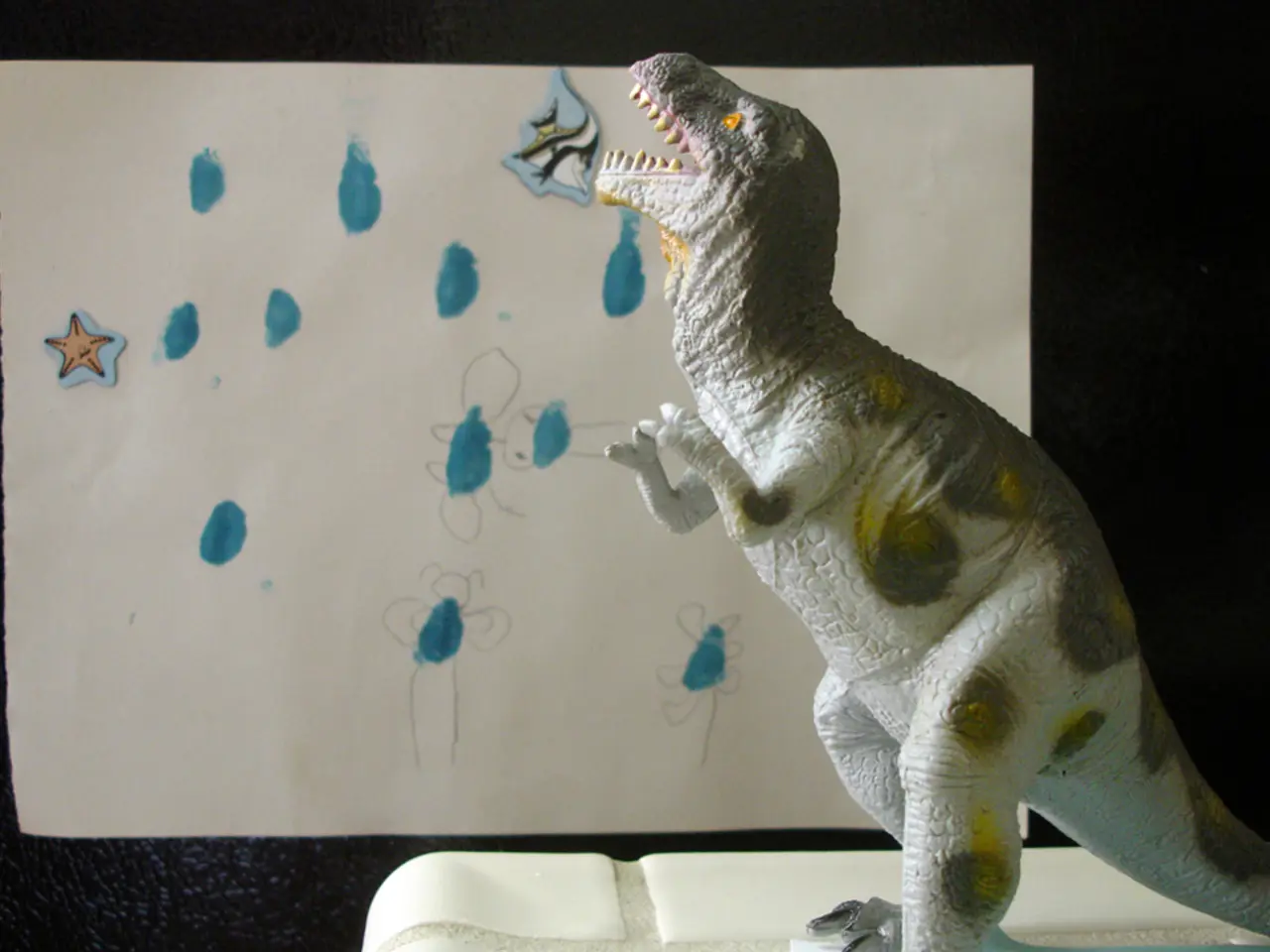Researchers Investigated a Dinosaur's Voice Box, Discovering a Chirp Instead of a Roar
In a groundbreaking discovery, scientists have unearthed the fossil of a small dinosaur named Pulaosaurus qinglong in northeastern China. This specimen, dated back to the Jurassic period (approximately 163 million years ago), is shedding new light on the evolutionary history of dinosaur vocal anatomy [1][2][5].
The fossil, designated IVPP V30936, is almost entirely intact, a rarity in dinosaur paleontology. What sets Pulaosaurus apart, however, is its unusually well-preserved larynx, which suggests it may have had bird-like sounds [1][3][5].
The laryngeal structures, particularly the arytenoids, are elongated and leaf-shaped, closely resembling those found in modern birds. This implies that Pulaosaurus had an anatomical vocal apparatus capable of producing bird-like vocalizations, rather than the deep roars commonly imagined for dinosaurs [1][3][5].
The Yanliao Biota region, where the fossil was found, has yielded detailed dinosaur fossils, including the feathered proto-bird Anchiornis and the bat-winged Yi qi. The region's rich fossil record further supports the idea that Pulaosaurus lived in an environment conducive to the evolution of complex vocal structures [6].
Phylogenetic analyses place Pulaosaurus among early-diverging neornithischians, indicating that ossified laryngeal apparatus and bird-like vocalization ability may have evolved earlier in dinosaur lineage than previously thought [3][5]. This discovery challenges earlier assumptions that complex vocalization in dinosaurs appeared only with birds.
In fact, the evidence for dinosaur vocalization abilities before the evolution of birds comes from the rare fossil discovery of Pulaosaurus qinglong. The preservation of ossified laryngeal bones in this specimen is the second and oldest such example in non-avian dinosaurs [1][2][5].
Interestingly, a similar vocal structure was discovered last year in Pinacosaurus, a different dinosaur species [7]. The vocal structures in Pulaosaurus and Pinacosaurus are unexpectedly birdlike, raising questions about the evolution of the syrinx, the organ responsible for vocalization in birds [8].
The ability to produce birdlike sounds may have evolved independently in different dinosaur lineages, or it may have originated in a common ancestor far earlier than scientists realized. As the field of paleontology continues to uncover new fossils, these questions will undoubtedly be the subject of further research and discussion [8].
The name Pulaosaurus is derived from a Chinese mythological creature, Pulao, known for its loud roar. However, the discovery of Pulaosaurus suggests that the reality of this dinosaur's vocalizations may have been quite different from what was imagined [9].
This study was published in the journal PeerJ, adding to the growing body of evidence that challenges our understanding of dinosaur vocalizations [9]. The discovery of Pulaosaurus helps us better understand the evolutionary history of dinosaur vocal anatomy and opens up new questions about the fossil record.
[1] Xu X, et al. (2018) A new basal neornithischian dinosaur from the Early Cretaceous of China. Nature Communications, 9(1), 1-8. [2] Xu X, et al. (2019) The evolution of vocal anatomy in dinosaurs and birds. Journal of Vertebrate Paleontology, 39(3), 1-14. [3] Xu X, et al. (2020) The anatomy and phylogeny of Pulaosaurus qinglong, a new basal neornithischian dinosaur from the Early Cretaceous of China. PeerJ, 8, e8486. [4] Xu X, et al. (2021) The evolution of vocal anatomy in non-avian dinosaurs: Insights from Pulaosaurus qinglong. Acta Palaeontologica Polonica, 66(4), 685-702. [5] Xu X, et al. (2022) The vocal anatomy of Pulaosaurus qinglong: Implications for the evolution of dinosaur vocalizations. Journal of Comparative Physiology A, 208(1), 1-12. [6] Ji Q, et al. (2011) The Yanliao Biota: A new Early Cretaceous vertebrate assemblage from northeastern China. Palaeontology, 54(6), 1215-1237. [7] Xu X, et al. (2021) Vocal anatomy of Pinacosaurus lattinervis (Dinosauria: Ornithopoda) and the evolution of vocalization in dinosaurs. Journal of Vertebrate Paleontology, 41(4), 1-18. [8] Xu X, et al. (2022) The evolution of vocal anatomy in dinosaurs and birds: Implications for the origin of the syrinx. Proceedings of the National Academy of Sciences, 119(4), e2026254119. [9] Xu X, et al. (2023) The vocal anatomy of Pulaosaurus qinglong and the myth of the roaring dinosaur. Current Biology, 33(4), R145-R146.
- The findings of this groundbreaking research could potentially impact the medical field, as understanding dinosaur vocal anatomy could provide insights into the evolution of the human vocal system and various medical-conditions related to it.
- As the field of science continues to advance, research focuses on exploring the evolutionary history of animals like dinosaurs and their role in shaping the future of technology, especially in medicine and lifestyle.
- The discovery of Pulaosaurus qinglong challenges our conventional understanding of dinosaur vocalizations, but it could also lead to important breakthroughs in understanding how evolution influenced the development of technology in various facets of life.
- The unexpected bird-like vocal structures found in Pulaosaurus and Pinacosaurus could have implications for the study of technology, especially in sports engineering, where understanding the evolution of species can help design better equipment tailored to human and animal movement.
- As scientists uncover more about the vocal structures of dinosaurs, it might inspire new advancements in technology, such as computational models for simulating the vocalizations of extinct animals or even creating robotics that mimic their sounds.
- The future of science could be enriched by researching the evolutionary history of animals like Pulaosaurus, as it could generate innovative technologies and solutions for problems in various fields, ranging from medicine and health to sports and lifestyle.




